Scaffolding Rental South Huntingdon
Find top Rent Scaffolding in South Huntingdon
Receive multiple Affordable Scaffolding Rental quotes for your project today! Compare profiles, reviews, accreditations, portfolio, etc... and choose the best deal.

Dynamic Hoisting & Scaffolding
54 reviews43-30 48th St, Long Island City, 11104, USAt Dynamic Hoisting & Scaffolding, we transform your vision into reality with our expertise in hoisting and scaffolding solutions. Our team is dedicated to delivering exceptional results, ensuring your projects are completed on time and within budget. Established in 2013, Dynamic Hoisting & Scaffolding is dedicated to providing high-quality construction services that exceed our clients' expectations. Our mission is to innovate, sustain, and continually improve every aspect of our work. Join us in transforming the construction landscape with our reliable scaffolding solutions. We use the highest quality materials and craftsmanship to ensure durability and excellence in every project. We conduct our business with transparency, honesty, and respect, prioritize the safety of our employees, clients, and the community, and embrace new technologies and methods to enhance efficiency and effectiveness.
- Services
- Why Us?
- Testimonials
- Gallery
Get Quote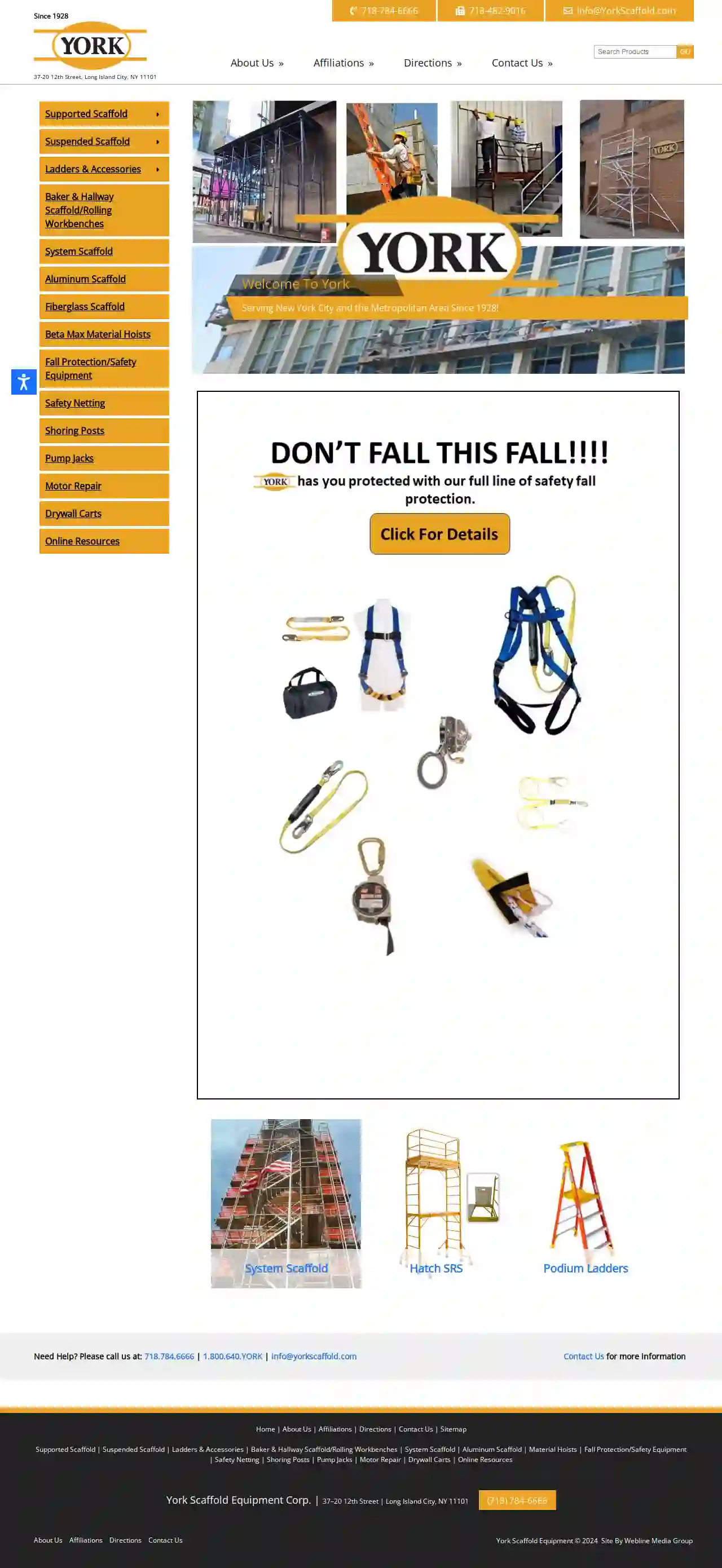
York Equipment Corp.
4.628 reviewsLong Island City, NY, 37-20 12th Street, 11101, USYork Scaffold Equipment Corp. has been serving New York City and the Metropolitan Area since 1928. The company specializes in providing a wide range of scaffolding solutions, including supported, suspended, and system scaffolds, as well as ladders, accessories, and safety equipment. With a strong commitment to customer satisfaction and safety, York Scaffold Equipment Corp. offers top-quality products and services to meet the needs of construction and renovation projects.
- Services
- Why Us?
- Accreditations
- Our Team
- Testimonials
- Gallery
Get Quote
Celtic Scaffolding Company
4.214 reviewsYork, USAt Celtic Scaffold, we specialize in providing top-notch scaffolding services to our clients in New York City. With years of experience in the industry, our team of experts is well-versed in the different types of scaffolds, including pipe scaffolds and hanging or suspension scaffolds. Our pipe scaffolds are stationary and constructed with pipes, erected from the ground up along the side of a building. We ensure that our pipe scaffolds comply with the regulations set by the Construction Division within each borough office of the Department of Buildings (DOB). On the other hand, our hanging or suspension scaffolds are supported from the roof or setback of a building and held by either cables or rope. We contract master riggers or special riggers for the work, and each worker using or operating the suspension scaffold must be employed by the master rigger, special rigger, or their company.
- Services
- Why Us?
- Gallery
Get Quote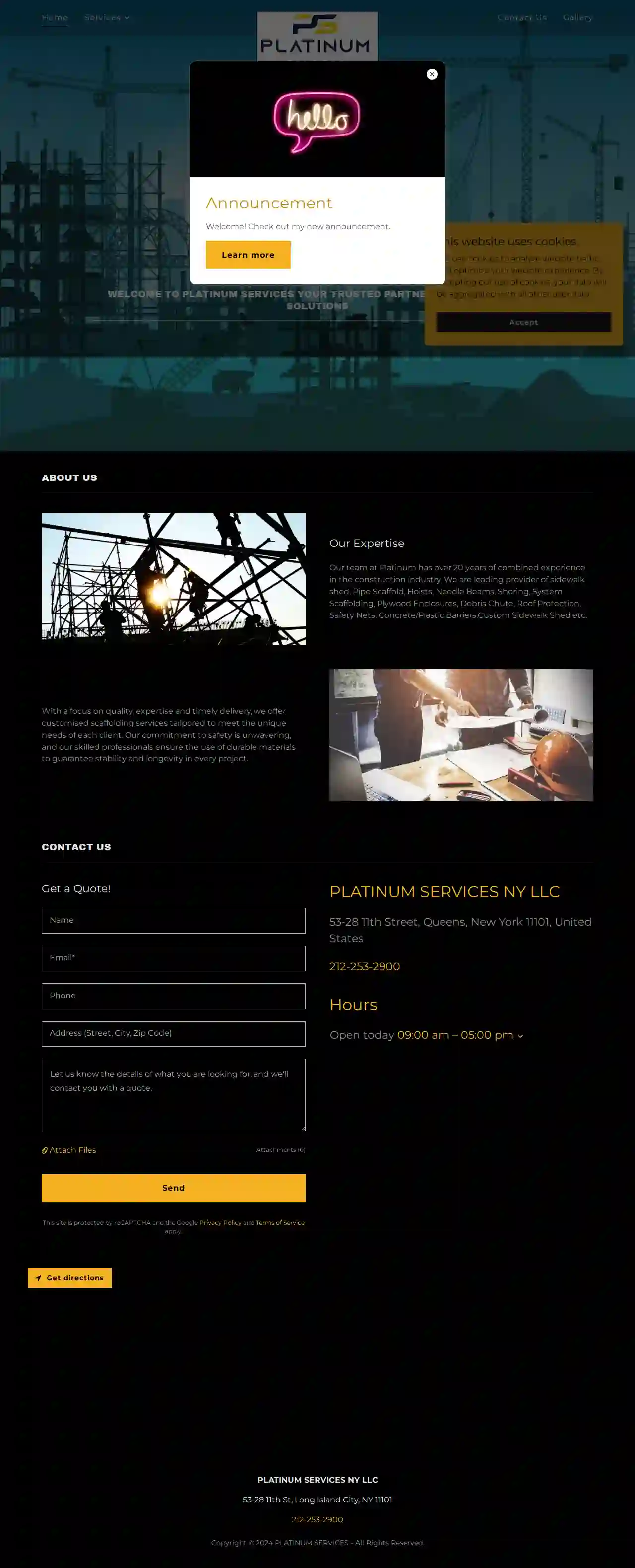
Platinum Services
34 reviews53-28 11th St, Long Island City, 11101, USWelcome to Platinum Services, your trusted partner in scaffolding solutions. With over 20 years of combined experience in the construction industry, our team at Platinum has the expertise to provide customized scaffolding services tailored to meet the unique needs of each client. Our commitment to safety is unwavering, and our skilled professionals ensure the use of durable materials to guarantee stability and longevity in every project. We offer a range of services, including sidewalk shed, Pipe Scaffold, Hoists, Needle Beams, Shoring, System Scaffolding, Plywood Enclosures, Debris Chute, Roof Protection, Safety Nets, Concrete/Plastic Barriers, and Custom Sidewalk Shed. Contact us today to get a quote and learn more about our services.
- Services
- Why Us?
- Gallery
Get Quote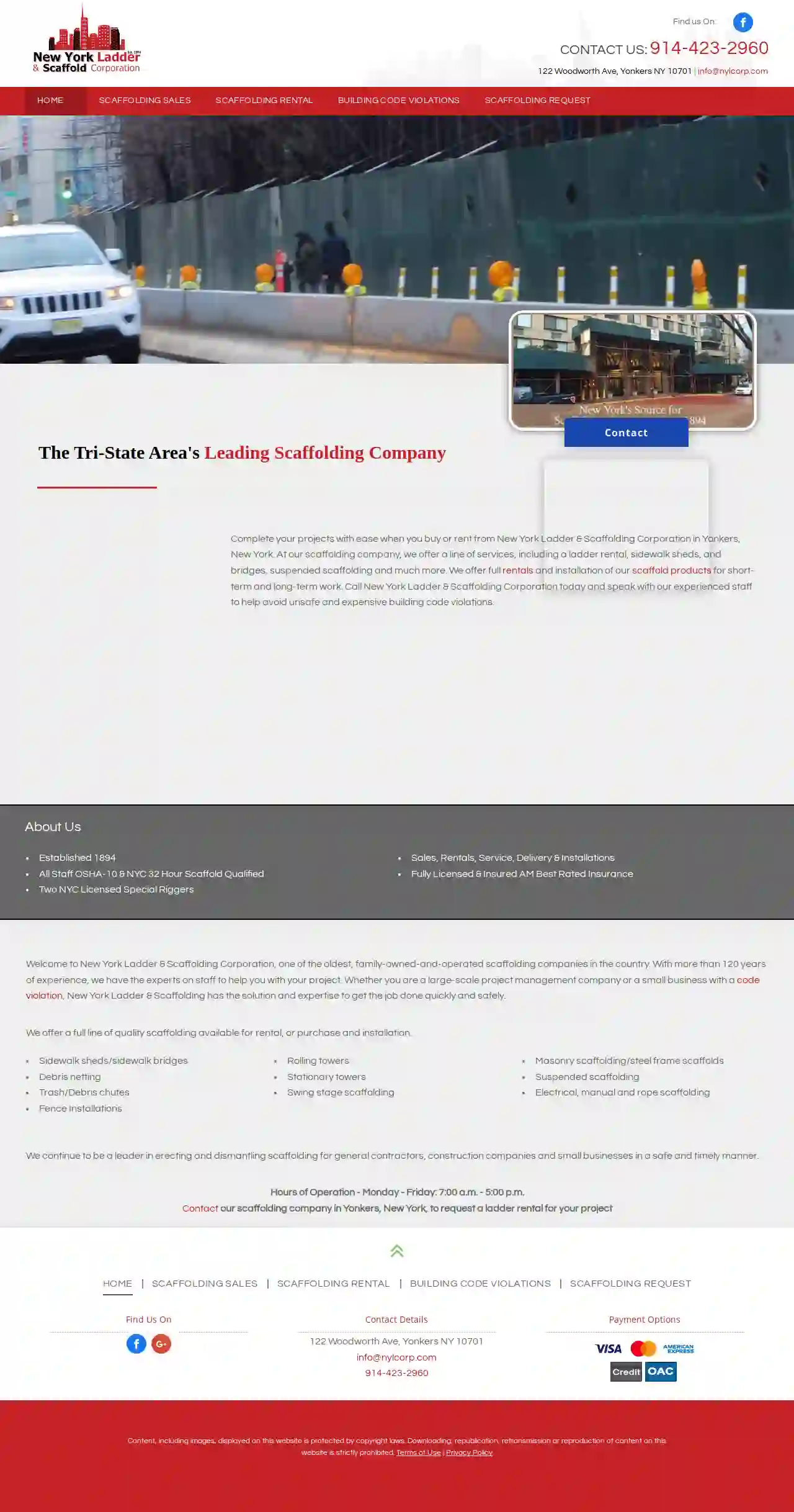
New York Ladder & Scaffold Corporation
46 reviews122 Woodworth Ave, Yonkers, 10701, USWelcome to New York Ladder & Scaffolding Corporation, one of the oldest, family-owned-and-operated scaffolding companies in the country. With more than 120 years of experience, we have the experts on staff to help you with your project. Whether you are a large-scale project management company or a small business with a code violation, New York Ladder & Scaffolding has the solution and expertise to get the job done quickly and safely. We offer a full line of quality scaffolding available for rental, or purchase and installation. Our services include sidewalk sheds/sidewalk bridges, debris netting, trash/debris chutes, fence installations, rolling towers, stationary towers, swing stage scaffolding, masonry scaffolding/steel frame scaffolds, suspended scaffolding, electrical, manual and rope scaffolding. We continue to be a leader in erecting and dismantling scaffolding for general contractors, construction companies and small businesses in a safe and timely manner. Our hours of operation are Monday - Friday: 7:00 a.m. - 5:00 p.m. Contact our scaffolding company in Yonkers, New York, to request a ladder rental for your project.
- Services
- Why Us?
- Accreditations
- Gallery
Get Quote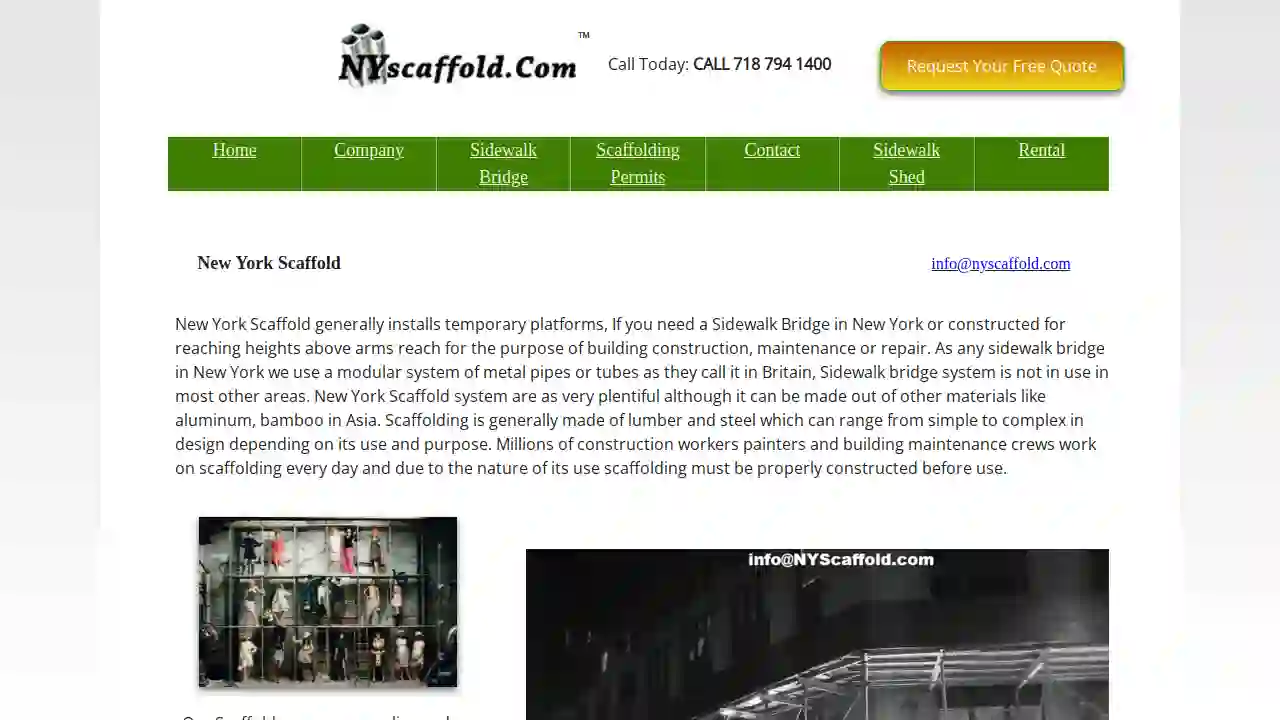
NY Scaffold
51 reviewsYork, USWe are national scaffold contractors and scaffolding erectors. Experienced NY Scaffold erectors can provide a range of access services for you or your clients, we also take care of any and all NYC DOB Permits. Large and small projects; industrial, commercial and domestic sectors can hire the services of NY Scaffold erectors. No job is too big or too small for us and we have grown our business in the last few years to become one of the leading erectors of scaffolding and sidewalk bridges in the NYC area. Plan your project with complete confidence the sidewalk bridge company NYC can erect scaffolding to all types of structures. NYC installs scaffolds from access towers to bridges and any other type of access equipment that your firm might require. It does not matter how big or how small your project is NY scaffold company NYC will cater to your needs. They have secure access equipment that is perfect for projects in and around the region. Our Scaffolding has several unique safety features that benefit the system’s erectors, users and project inspectors. With eight completely variable component node points and the largest available bay sizes, Our Scaffolding offers the most flexible system. Only five main components are required for basic use and the only erection tools required are a hammer and level. The system’s optimum design offers a high load rating and extreme rigidity, keeping your workers secure and productive. NY Scaffold is the leading specialty Scaffold Erector Company covering the whole of the US. We are totally focused on customer satisfaction and pride ourselves on the range of services we provide, We have 95% repeat business on an ongoing basis. NY Scaffold is fully self-sufficient and one the largest stockholders of the sidewalk bridge system within the US. This forms the basis of the NY Scaffolds motto safety speed efficiency. Our business is based around the materials that are stored in bins and are loaded by forklift in our yards and unloaded on site by our Truck mounted Booms. We deliver our scaffolding equipment to your site, and our team of experienced erectors will set it up for you, ensuring that your project is completed safely and efficiently.
- Services
- Why Us?
- Gallery
Get Quote
Kings Group NY Corp
51 reviews120-5 Atlantic Ave, Suite #2, Richmond Hill, 11418, USAt Kings Group NY, we prioritize Safety and Quality in every project we undertake. Our mission is to ensure that our clients receive the best possible service, from the initial consultation to the completion of the project. With a team of experienced professionals, we provide top-notch scaffolding services to contractors, construction managers, developers, and building owners. Our organization is committed to meeting project budgets, schedules, and daily safety codes, and we take pride in our ability to deliver exceptional results. Our team is comprised of NYC DOB and OSHA code-certified professionals who are dedicated to providing the highest level of service. We offer a range of services, including sidewalk sheds, scaffolding, hoists, and other specialized services. Our goal is to provide our clients with the best possible experience, and we strive to exceed their expectations in every way.
- Services
- Why Us?
- Accreditations
- Gallery
Get Quote
NYC Sidewalk Shed & Pipe Scaffolding
51 reviews1078 Arnow Ave, Bronx, NY, USAbout NYC Sidewalk Shed & Pipe Scaffolding NYC Sidewalk Shed & Pipe Scaffolding is the most trusted provider of premium quality sidewalk sheds and pipe scaffolding in NYC. We are the leading pipe scaffolding and sidewalk erector company, providing services in the whole of NYC. As a result of 20+ years of experience in the industry, we have become adept in providing high-quality sidewalk sheds and pipe scaffoldings consistently earning the satisfaction of all our clients. Our Mission At NYC, our mission is to provide excellent sidewalk shed and scaffolding services at extremely affordable rates. Hence, providing quality and safety that’s within everyone’s’ reach. From modern equipment to the best professionals, we try to cater to you with the best in every aspect. We aim to completely redefine what is possible in the construction industry by setting new standards for safety, efficiency, and innovation. Why Choose Us Providing you with high-quality solutions for all your problems is our foremost concern. We work with skilled professionals that have years of experience in dealing with sidewalk sheds and pipe scaffoldings. Besides, we make sure to use the best quality material sourced from the best manufactures. Hence, ensuring you quality structures that can withstand the test of time. Duralbes and Safe Structures We design safe and reliable pipe scaffoldings and sidewalk structures that can easily support the desired load. These structures will be stable and robust ensuring safety for everyone. Moreover, we assure compliance with both local and international safety codes, ensuring the complete safety of pedestrians and site workers from all sorts of accidents.
- Services
- Why Us?
- Gallery
Get Quote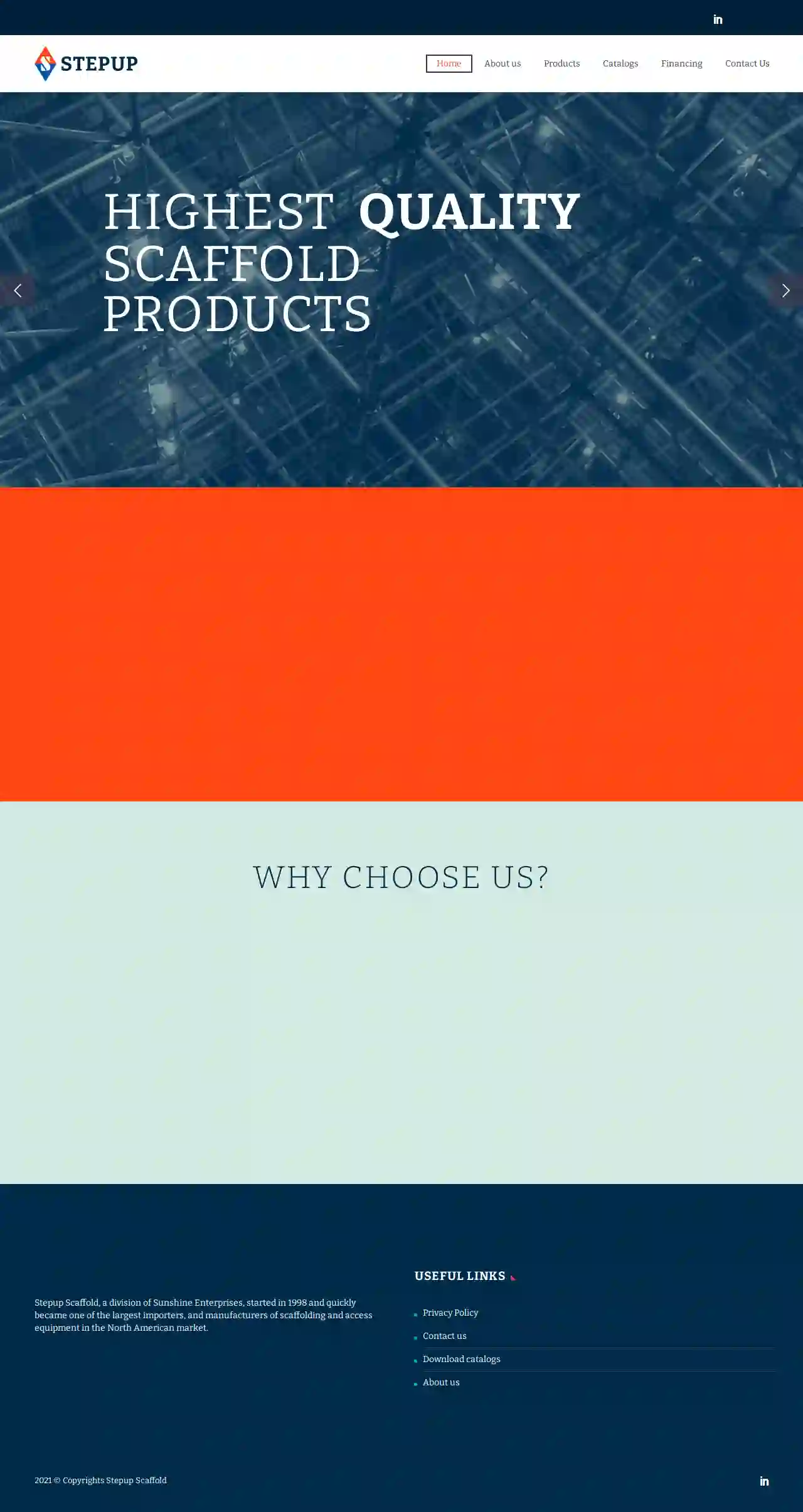
StepUp Scaffolding Warehouse - NY Branch
4.426 reviews1234 NW 12th St, Miami, 33122, USStepup Scaffold, a division of Sunshine Enterprises, started in 1998 and quickly became one of the largest importers and manufacturers of scaffolding and access equipment in the North American market. Our commitment to Quality, Service, and Satisfaction influences everything we do. We believe that a high tide raises all boats, so to raise everything and everyone, our statement of purpose, simply put is that “We elevate our employees, customers, and industries to safely move, build, and maintain the world.”
- Services
- Why Us?
- Accreditations
- Our Team
- Testimonials
- Gallery
Get Quote
MG Rigging & Scaffolding Services
51 reviews48-11 69th Street, Woodside, 11377, USMG Rigging and Scaffolding Services is a one-stop shop for Suspended Access needs in NYC, NY, Long Island, and New Jersey. With hands-on rigging experience and extensive knowledge of products and regulations governing the scaffolding industry, our staff provides top-notch services. From Suspended Scaffolding Rental, Installation, and Sales to Special Rigger Services and Rigging Safety consulting, we've got you covered. Our team assists Engineers and Architects with Local Law 11 Facade Inspections and Repairs, and we offer Engineered Plans, CD5 Permits, DOL Permits, and Expediting. We're committed to providing exceptional service and ensuring your project is completed safely and efficiently.
- Services
- Why Us?
- Accreditations
- Gallery
Get Quote
Over 2,353+ Scaffolding Businesses on our platform
Our scaffolding companies operate in South Huntingdon & surrounding areas!
ScaffoldingHQ has curated and vetted the Best Scaffolding Companies in South Huntingdon. Find the most trustworthy contractor today.
Frequently Asked Questions About Scaffolding Rental
- Scaffolding Boards: Wooden planks or metal grating that form the working platform.
- Base Plates: Provide a stable foundation for scaffolding legs, often adjustable to accommodate uneven ground.
- Ladder Access: Ladders or stairs allow safe access to and from the scaffolding platform.
- Castors (Wheels): Used for mobile scaffolding, allowing for easy movement.
- Braces and Ties: Strengthen and stabilize the scaffolding structure.
- Safety Nets: Catch falling objects and prevent debris from reaching the ground.
- Weather Protection: Screens or covers protect workers from wind, rain, or sun.
- Construction: Building new structures, adding extensions, and performing facade work.
- Renovation and Repair: Repairing or replacing roofs, siding, windows, and gutters.
- Maintenance: Cleaning windows, painting, and performing general upkeep on buildings.
- Industrial Work: Accessing elevated equipment, performing inspections and repairs on industrial structures, and carrying out construction work in industrial settings.
- Events: Creating temporary stages, grandstands, and platforms for concerts, festivals, and sporting events.
- Type of Scaffolding: Tube and clamp, system scaffolding, mobile towers, and specialized systems have different rental rates.
- Scaffolding Size and Height: Larger and taller scaffolding structures require more materials, increasing the cost.
- Rental Duration: The length of the rental period will significantly affect the price.
- Location: Rental rates can vary by location due to differences in labor costs and demand.
- Delivery and Setup: Some companies charge extra for delivery, erection, and dismantling services.
- Stop Using It Immediately: Do not attempt to use damaged scaffolding. It could be unsafe.
- Contact the Rental Company: Notify the scaffolding rental company about the damage as soon as possible.
- Document the Damage: Take photos or videos of the damage for documentation. The rental agreement should outline the procedures for handling damaged equipment. You may be responsible for repair or replacement costs, depending on the circumstances and the terms of the agreement.
What are some common scaffolding accessories?
What is scaffolding used for?
How much does it cost to rent scaffolding?
What happens if the scaffolding is damaged during my rental period?
What are some common scaffolding accessories?
- Scaffolding Boards: Wooden planks or metal grating that form the working platform.
- Base Plates: Provide a stable foundation for scaffolding legs, often adjustable to accommodate uneven ground.
- Ladder Access: Ladders or stairs allow safe access to and from the scaffolding platform.
- Castors (Wheels): Used for mobile scaffolding, allowing for easy movement.
- Braces and Ties: Strengthen and stabilize the scaffolding structure.
- Safety Nets: Catch falling objects and prevent debris from reaching the ground.
- Weather Protection: Screens or covers protect workers from wind, rain, or sun.
What is scaffolding used for?
- Construction: Building new structures, adding extensions, and performing facade work.
- Renovation and Repair: Repairing or replacing roofs, siding, windows, and gutters.
- Maintenance: Cleaning windows, painting, and performing general upkeep on buildings.
- Industrial Work: Accessing elevated equipment, performing inspections and repairs on industrial structures, and carrying out construction work in industrial settings.
- Events: Creating temporary stages, grandstands, and platforms for concerts, festivals, and sporting events.
How much does it cost to rent scaffolding?
- Type of Scaffolding: Tube and clamp, system scaffolding, mobile towers, and specialized systems have different rental rates.
- Scaffolding Size and Height: Larger and taller scaffolding structures require more materials, increasing the cost.
- Rental Duration: The length of the rental period will significantly affect the price.
- Location: Rental rates can vary by location due to differences in labor costs and demand.
- Delivery and Setup: Some companies charge extra for delivery, erection, and dismantling services.
What happens if the scaffolding is damaged during my rental period?
- Stop Using It Immediately: Do not attempt to use damaged scaffolding. It could be unsafe.
- Contact the Rental Company: Notify the scaffolding rental company about the damage as soon as possible.
- Document the Damage: Take photos or videos of the damage for documentation. The rental agreement should outline the procedures for handling damaged equipment. You may be responsible for repair or replacement costs, depending on the circumstances and the terms of the agreement.